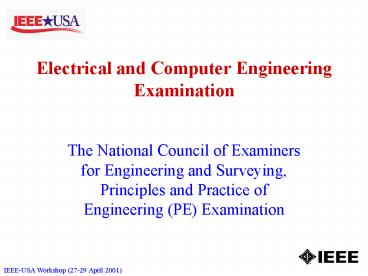Electrical and Computer Engineering Examination - PowerPoint PPT Presentation
1 / 15
Title:
Electrical and Computer Engineering Examination
Description:
All examinees work the breadth (AM) module and one of the three depth (PM) modules. ... has questions from the general field of electrical and computer engineering. ... – PowerPoint PPT presentation
Number of Views:18
Avg rating:3.0/5.0
Title: Electrical and Computer Engineering Examination
1
Electrical and Computer Engineering Examination
- The National Council of Examiners for Engineering
and Surveying,Principles and Practice of
Engineering (PE) Examination
2
PE Exam Changes Ahead
- On January 5, 2001 NCEES announced the new name
Principles and Practice of Electrical and
Computer Engineering Examination. - A new Breadth and Depth format for the PE exam
was approved by the EPE Committee of NCEES on
August 25, 2000. - The effective date for both changes is April 2002.
3
New Name
- By changing the name of the exam, we are
identifying to computer engineers that this is
their exam for licensure, says Aaron Collins,
Ph.D., P.E., Chair of the NCEES Electrical
Subcommittee. - The number of students majoring in computer
engineering is about equal to the number of
students majoring in electrical engineering.
4
New Exam
- Breadth and depth format examination.
- All examinees work the breadth (AM) module and
one of the three depth (PM) modules. - The breadth examination has questions from the
general field of electrical and computer
engineering. - The depth examinations focus more closely on a
one general area of practice in electrical and
computer engineering.
5
Three Depth Modules
- Computer Engineering Depth Module
- Electronics, Control, and Communication
Engineering Depth Module - Power Engineering Depth Module
6
Number of Questions
- Each of the four modules contains forty (40)
multiple-choice (ABCD) questions. - All examinees must work all questions on the
breadth module. - All examinees must work all questions on one
depth module of their choice. - Thus, all examinees must work a total of eighty
(80) multiple-choice (ABCD) questions.
7
Exam Module Content
- The following slides show the subjects tested by
the breadth module and each of the depth modules. - The knowledge areas listed are examples of the
kinds of knowledge topics represented by the
category. They are neither exclusive nor
exhaustive of all knowledge areas in each
category.
8
Breadth (AM)
- Basic Electrical Engineering 22
- Professionalism and Engineering Economics
- Safety and Reliability
- Electric Circuits
- Electric and Magnetic Field Theory and
Applications - Digital Logic
9
Breadth (AM)
- Electronics, Electronic Circuits and Components
10 - Components
- Electrical and Electronic Materials
- Control and Communication Systems 8
- Power 10
- Transmission and Distribution
- Rotating Machines and Electromagnetic Devices
10
Computer Engineering (PM)
- General Computer Systems 5
- Interpretation of Codes and Standards
- Microprocessor Systems
- Hardware 22
- Digital Electronics
- Design and Analysis
- Systems
11
Computer Engineering (PM)
- Software 18
- System Software
- Development/Applications
- Networks 5
12
Electronics, Control, and Communication (PM)
- General Electrical Engineering Knowledge 5
- Measurement and Instrumentation
- Interpretation of Codes and Standards
- Computer Systems
- Electronics 18
- Electric Circuit Theory
- Electric and Magnetic Field Theory and
Applications - Electronic Components and Circuits
13
Electronics, Control, and Communication (PM)
- Control 12
- Control System Fundamentals
- Control System Design/Implementation
- Stability
- Communication 15
- Communications and Signal Processing
- Noise and Interference
- Telecommunications
14
Power (PM)
- General Power Engineering 7
- Measurement, Instrumentation and Statistics
- Special Applications
- Codes and Standards
- Circuit Analysis 14
- Analysis
- Devices and Power Electronic Circuits
- Electric and Magnetic Fields and Applications
15
Power (PM)
- Rotating Machines and Electromagnetic Devices 14
- Rotating Machines
- Electromagnetic Devices
- Transmission and Distribution 15
- System Analysis
- Power System Performance
- Protection

